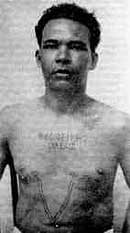
1895 - 1984
Febrônio Índio do Brasil
Summary
Name:
Years Active:
1925 - 1927Birth:
January 14, 1895Status:
DeceasedClass:
Serial KillerVictims:
6+Method:
Strangulation / Beating / StabbingDeath:
August 27, 1984Nationality:
Brazil
1895 - 1984
Febrônio Índio do Brasil
Summary: Serial Killer
Name:
Febrônio Índio do BrasilStatus:
DeceasedVictims:
6+Method:
Strangulation / Beating / StabbingNationality:
BrazilBirth:
January 14, 1895Death:
August 27, 1984Years Active:
1925 - 1927bio
Febrônio Índio do Brasil was born on January 14, 1895, in São Miguel de Jequitinhonha, Brazil. He was the second of fourteen children in the family of Theodoro Simões de Oliveira and Reginalda Ferreira de Mattos. Many sources suggest his real name was Febrônio Ferreira de Mattos, but he became known as Febrônio Índio do Brasil, meaning "Son of Light."
His father, Theodoro, was a farmer and was known to have worked as a butcher too. He struggled with alcoholism and was often violent towards his wife and children. Febrônio saw his mother suffer from these beatings, which likely affected him deeply. At the age of 12, around 1907, he fled his home. He left with a traveling salesman and started wandering through different areas until he reached the city of Diamantina. There, he learned to read and worked as a butler.
Over the next few years, Febrônio moved to Belo Horizonte, where he made a living shining shoes and working as a domestic servant. By 1909, when he was about 14 years old, he traveled to Rio de Janeiro, the federal capital at that time. He returned to Minas Gerais in 1916, using the name Pedro de Souza, but soon he went back to Rio de Janeiro again.
murder story
Febrônio Índio do Brasil began his series of crimes after a lengthy history of legal troubles, including arrests for various offenses between 1916 and 1929. In January 1927, while in jail, he sexually assaulted two of his cellmates. During an attempt to attack a third inmate, he killed Djalma Rosa when Rosa resisted.
On February 21, 1927, while behaving erratically on Corcovado hill, he was caught dancing naked in front of a child who was tied to a tree. Eyewitnesses reported that Febrônio had been seen cooking a human head at his residence. He was returned to the National Psychopath Hospital after this incident. There, doctors confirmed his mental illness.
In April 1927, Febrônio was released and took another inmate, Jacob Edelman, with him, promising him work. He then met another young man, Octávio de Bernardi, and took both to a remote area where he tattooed Jacob against his will. Later, he sexually assaulted both boys but eventually released them unharmed.
By August 1927, Febrônio had escalated his criminal behavior. He lured 20-year-old Alamiro José Ribeiro to accept a job. When Alamiro rejected Febrônio's advances, Febrônio strangled him with a vine. Alamiro's body was discovered two days later.
In the same month, he approached a 16-year-old boy named Joaquim with deceptive job offers but Joaquim managed to escape. Febrônio then traveled to Petrópolis, assuming the identity of a dentist, but while there, he attacked a tailor. He later returned to Rio de Janeiro.
On August 29, 1927, he kidnapped 10-year-old João Ferreira, known as "Jonjoca." Febrônio persuaded Jonjoca's parents to allow him to take the boy for a job. After tattooing Jonjoca, he took him to a forest where he strangled him. Jonjoca's corpse was found days later, close to where Alamiro's body had been discovered.
Following these murders, Febrônio was arrested on August 31, 1927. He was identified by the victims' families and confessed to both murders under the claim they were sacrifices for his religious beliefs. In September 1927, officials charged him with the murders of Alamiro and Jonjoca.
After evaluations by multiple psychiatric experts, it was concluded that Febrônio had a severe mental disorder that impaired his understanding of his actions. In 1928, he was acquitted due to insanity and transferred to a psychiatric institution instead of a prison.
Febrônio attempted to escape from the psychiatric hospital in February 1935 but was recaptured the next day. He remained in custody until his death from pulmonary emphysema on August 27, 1984. His remains were buried quietly in September 1984.